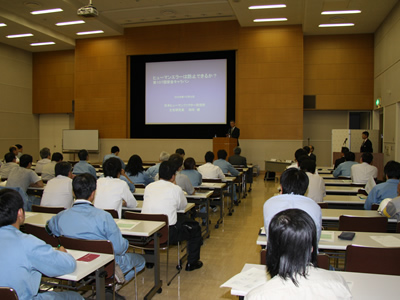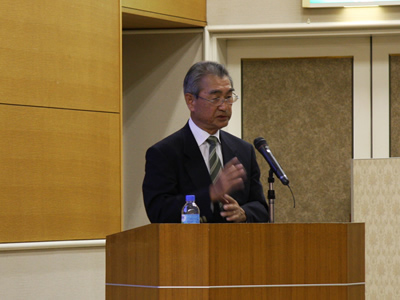
|
|
During the Safety Presentation
|
Approximately 84 employees of IHI Corporation's offices attended the Safety Presentation.
Mr. Akira Sakai, Deputy Manager of the Nuclear Power Division, gave this opening statement: "The IHI Nuclear Power Division carries out operations related to developing designs for nuclear power plants, equipment for spent fuel reprocessing facilities, and large-scale equipment for chemical plants. In all of our operations, our policy is placing the utmost priority on quality. In the event that nonconformities should occur, we strive to prevent reoccurrence through analyzing factors from either the engineering side or the management side. However, when these factors involve careless mistakes and other human errors, preventing reoccurrence is rather difficult; this is because the cause stems from the limits of being human. Using the ideas presented by Mr. Tadokoro today, we will continue our efforts to prevent human error.
After this opening statement, Mr.Tadokoro (senior research fellow at the Japan Institute of Human Factors) began his presentation entitled "Can Human Error be Prevented?
|

|
|
Mr.Tadokoro
senior research fellow,
Japan Institute of Human Factors
|
●An Overview of Human Factors
"Human Factors" is a term which covers the knowledge concerning human ability, limits, and characteristics. As the name suggests, it is a uniquely "human" problem. Although human factors may be a factor in causing error, it is not all negative, and even has its upsides; an example being the seasoned expert whose skill surpasses those of machines. The M-SHEL model is the most widely used and easy to understand human factor model concerning system safety.
●Human Error Factors
As human error is an error caused by a human being, it can be considered a human characteristic. The cause stems from a facet of humanity which can be considered fondly, and can never be completely erased. There is no such thing as an "error" mode for the human mind; rather, an error is simply the unfortunate outcome of our best efforts. A vast world of difference lies between the error made by a novice and the error made by an expert; this difference is one which managers must thoroughly understand.
●Measures Against Human Error
As a rule, there are two types of measures that can be taken against human error: there is "Error Resistance," which involves keeping the number of errors which occur as low as humanly possible; and there is "Error Tolerance," which involves preventing errors from leading to accidents, and keeping the bodily harm caused by an accident to minimal levels. Many specific measures exist for each step of operation, and it is important that these are well understood.
●Considerations for Safety
Lawrence once famously said that "Safety is simply the most acceptable risk." In the spirit of these words, we should consider the illusion of safety to be just that; an illusion.
From the 70's to the 80's, massive and complicated systems such as the space program, nuclear power stations, and jumbo jets lead to new and unprecedented accidents; as a result, it was no longer enough to simply learn from trial and error. It was because of this that preventative safety was invented and developed - a proactive safety method of finding the dangerous elements in the everyday, to deal with and dispose of them ahead of time.
●The Importance of Safety Culture
The catastrophe which occurred in the USSR in1986, at the Chernobyl Nuclear Power Station shook the world. The IAEA (International Atomic Energy Agency), concerned over an accident occurring at a nuclear power station when they were operating across the globe, analyzed the factors which caused this accident with INSAG (International Nuclear Safety Group). Their efforts culminated in a report released in 1991, entitled "Safety Culture," which explained the concept of Safety Culture to those in the nuclear power business worldwide. Today, Safety Culture is a concept known far and wide, becoming deeply rooted in various businesses.
●Lecture Highlights
As long as we are human, we will never bring human error to zero; however, we can work to reduce them. We can work to ensure that errors do not cause accidents. And even if the unfortunate happens and an accident occurs, we can suppress the damage caused to a minimum.
In the questionnaire after the presentation, the following opinions were expressed.
●This presentation was very easy to understand. It also gave me motivation to work toward reducing the number of mistakes made, since it did not put undue pressure on fear of failure.
●The information I gained in this presentation can be reflected in my work, and was very helpful.
●As a result of the increased importance placed on safety and cooperation within an organization, we had the opportunity to hear this valuable explanation on the mechanisms of human error. However, I would have liked to hear more specific examples used, such as the story about Qantas Airlines.
●Although human error can never be erased, the measures to reduce their number was extremely helpful. I feel that continued implementation of these measures is vital.
|







